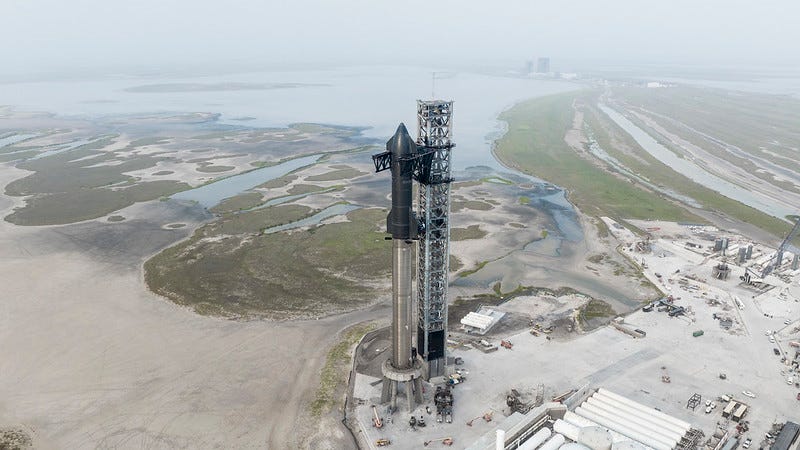
The unsurprising but still shocking news that Elon Musk’s SpaceX Starbase is blowing chunks of concrete and fiery debris into nearby migratory bird habitat has me thinking about Christopher Brown, who lives a few hours’ drive from the Starbase and a few miles upstream from Musk’s Tesla Motors Gigafactory in Austin, Texas. SpaceX promised that the Starbase would have a “small, eco-friendly footprint”; similarly, Musk promised that the 2,500-acre Tesla operation would turn the nearby Colorado River into an “ecological paradise.” As Brown writes in his forthcoming book A Natural History of Empty Lots, that stretch of the Colorado already was a paradise, especially by urban standards. What it needed was care and attention, not a massive new industrial site greased with obvious whoppers.
Brown lives in what he calls the “edgelands” of Austin, on a lot that he bought for a steal in 2009. Since then, Brown and his family have gotten acquainted with their wounded but still-vibrant ecosystem, built a house that reflects the area’s past and possible futures, and reseeded their lot with plants from the Blackland Prairie, which once stretched from Dallas to San Antonio.
While Elon touts the dream of a “multiplanetary society,” Brown—and all those repairing landscapes large and small—offer a different, more attainable vision. They believe we can, and must, affirm and rebuild human relationships with all the ecosystems we have here on Earth. And they’re showing that it’s possible to do so with creativity and grace.
News from all over
If you thought the U.S. Congress was talking about one thing and one thing only this week, think again. The bipartisan America’s Conservation Enhancement Reauthorization Act received a subcommittee hearing on Monday and is now eligible for a full hearing in the House Natural Resources Committee.
One of the basic assumptions of modern conservation is that regulations will follow science. The U.S. Supreme Court’s overturning of Chevron deference has effectively burned that assumption to the ground, but this story from Wyofile finds some hope among the ruins. (For a thorough and darkly funny overview of the SCOTUS decision, try this episode from Strict Scrutiny.)
With excellent timing, a brand-new paper in Nature Ecology & Evolution *shakes fist at journal paywalls* confirms the premise of this newsletter. Finnish ecologist Anni Arponen analyzed two recent studies, one that reported global shortfalls in efforts to protect threatened species and another finding that two-thirds of conservation actions worldwide either reverse or slow down biodiversity declines. Arponen’s conclusion is that conservation works, but (and of course there’s a but) it must be scaled up.
As climate chaos increases, we’re seeing more and more examples of conservation as a climate adaptation. Daniel Shailer of Inside Climate News reports on a historically Black community near Charleston, South Carolina, whose members are turning to conservation measures as a defense against both gentrification and rising seas.
I recently talked to two ethicists about the plan to kill nearly half a million barred owls over the next 30 years in order to protect the threatened northern spotted owl. In Atmos, Isobel Whitcomb reflects on a related and very poignant question: whether barred owls should be treated as members of an invasive species or as climate refugees.
Indian Country Today has an encouraging story about the growing number of Indigenous leaders within the big environmental NGOs, pointing to the work of leaders including Heather Dawn Thompson (Cheyenne River Sioux), an incoming vice president for the World Wildlife Fund; Fawn Sharp (Quinault), a member of The Nature Conservancy’s board of directors; and Barbara ‘Wáahlaal Gidaag Blake (Ahtna Athabascan, Haida and Tlingit), a vice president of the Ocean Conservancy.
Words we need
One thing I’ve learned from years of writing about conservation is that the English language doesn’t have enough words for it, and those that we do have can be counterproductive. Even the most basic, like “nature,” reinforce the culturally-imposed distinction between humans and our ecosystems. I’ll use this section to recommend some words for wider use. Suggestions welcome!
Between town and country there has developed a new type of landscape different from either and endowed with distinctive characteristics of its own. Characterised by an anarchic mix of unloved land-use functions ranging from gravel workings to sewage disposal plants set in a scruffy mixture of unkempt fields, derelict industrial plant and miscellaneous wasteland, it has been ignored by public and planners alike. However, it has important qualities: it is a refuge for wildlife driven out of an increasingly inhospitable countryside; it is a living museum of the workings of contemporary society; and it has considerable, untapped recreational potential.
—Marion Shoard, “Edgelands of Promise,” 2013
British ecologist Marion Shoard coined the term “edgelands” to describe the landscapes between city and countryside, and Christopher Brown, in his book, adapts the term to his North American context, using it to describe the urban spaces he has come to see as hidden wildernesses—“topographies we can never really occupy, even as we encroach as closely as we can.” These are places usually referred to as “brownfields” or “dumping grounds,” if they’re called anything at all; “edgelands” doesn’t dismiss their problems but captures their possibilities.






Great to see you here, and loved reading this!
Welcome, Michelle, it's good to see you here.